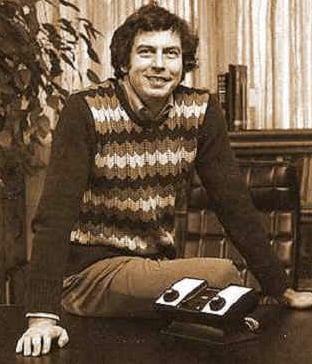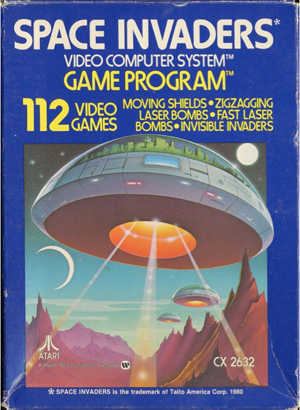Original URL: https://www.theregister.com/2012/06/27/atari_40_anniversary/
Atari turns 40: Pong, Pac-Man and a $500 gamble
Did 1980s joystick deathgrip give you a claw hand?
Posted in Personal Tech, 27th June 2012 16:00 GMT
Forty years ago today, one of the most iconic names in computing was born: Atari.
With just $500 between them, Nolan Bushnell and Ted Dabney founded Atari on June 26, 1972. Atari quickly became a successful computer games company: titles for Atari broke the one million units sold barrier and 10 years later Atari was making $2bn in annual sales. The company built the world's first popular home video game console, employed Apple founder Steve Jobs and put Pac-Man and Space Invaders into millions of living rooms.
Atari succeeded at a time when there was no games biz, or even a PC industry as we know it today. Early components were built from scratch, the systems and manufacturing processes constructed for the very first time, and game play might be sketched out on the back of an envelope, ripped from an existing arcade title - or just stolen from the competition.

Bushnell with the Pong home console
Atari's success, however, came from one very simple game indeed: Pong. And Pong itself was born from a game called chance.
Nolan had been working in games arcades in Salt Lake City so saw the potential for people paying to have a good time. He tossed engineer Al Alcorn the job of building Pong to test his skills in building a version of another successful arcade game of the time.
Where did Bushnell get the idea for Pong? It seems from a visit to the office of Magnavox, makers of the world's first home video game console - the lesser-known Odyssey. Bushnell attended a demonstration by Magnavox on 24 May, 1972. Bushnell founded Atari on June 27 and Magnavox later sued Atari, along with others, for patent infringement.
Bushnell and Alcorn sold home Pong to their first distributor, US retailer Sears Roebuck in Chicago, before the unit had actually been manufactured - they had a working prototype.
As Alcorn recalled for The Reg, the buccaneering pair demonstrated Pong to the suits at Sears in 1974 who were interested in putting Pong in their Christmas catalogue. The Sears suits in their meeting recounted in great detail how they'd only had one product recall from that great catalog - a malfunctioning slot car.
"Nolan and I are listening to this and thinking: 'If this happens to us, we're out of business. We're risking the whole business on this thing,'" Alcorn said here.
Fortunately, they had Steve Jobs on their side. Or, rather, Steve Woz. Jobs had worked briefly with the Atari team in 1974 to build this single-player version of Pong, helping devise the prototype's hardware. He enlisted the help of his Apple co-founder, who was then working at Hewlett-Packard, and went on to architect the Apple I and II - two of the first CLI-based personal computers.
Pong was a blowaway success: nearly 150,000 home versions of Pong shipped at $100 a pop during Christmas 1975 with eager consumers lined up outside in the cold just to get on a waiting list.
Already change was needed, though, as the industry had recognized the potential for terminals that played different games loaded on interchangeable cartridges and Nolan needed money to build Atari's cartridge system, the 2600. This would be the system that consolidated Atari's place in the home and forged its iconic status. Bushnell sold Atari to Warner Communications for $28m in 1977, staying on as Atari chairman.
Again, as with Pong, Atari wasn't first but it did outsell its nearest competitor Intellivision. Delivered in 1977, the 2600 sold 30 million units during its lifespan. It arguably established the business model for today's games market: a successful hardware platform combining graphics, power and speed - today that would be a Playstation, Xbox, or iPhone - fed by popular titles that exploited the graphics, performance and so on.
Two things stood in the 2600's favor: the absence of PCs that might compete it out of the market and the accessibility of the games. Titles were bright and fun, and the game play simple - shoot or move.
Attack, attack, attack!
Atari had a growing stable of titles but it was one arcade hit that really made the 2600 stand out: games publisher Taito's Space Invaders, in 1980, racked up one million sales. The most successful game for the Atari 2600 was Pac-Man, also in 1980. Pac-Man had been designed and built by Toru Iwatani at another publisher, Namco, initally as an arcade game for women and couples. Legend has it that Iwatani decided to base the game on eating and Pac-Man is a pizza with a slice missing.
The decision to attract women gamers and novices is what made Atari special and successful, and that helped it consolidate its name rather than becoming just another games console consigned to history. Alcorn outlined the Atari philosophy here and the philosophy remains a goal for today's games makers as they try to grow.
Of course there were detractors of Pac-Man on Atari: the original arcade game snobs who complained the ghosts on the Atari 2600 flickered. Such people were in the minority and Pac-Man is the 2600's best selling game with seven million units shipped.
If the Atari 2600 had one fault, it was the joystick - all stick, little joy. With no apology to design, Atari's basic controller wasn't molded to your hand, it was all stick and that meant endless hours of Pac-Man followed by Battlezone for your correspondent resulted in painful claw-hand syndrome in Christmas 1982.

In your space: the Atari 2600's first big hit
This was Atari's high-water mark. Bushnell himself had left in 1977 to create Chuck E Cheese pizza restaurants, beloved of US children because it combines pizza and game play. Atari, meanwhile, was split in two in 1984 and sold on the back of what became known as the North American video game crash between 1983 and 1985 when revenues dropped by 97 per cent. Atari, and others, had become too successful - they'd saturated the available market and seemed unable to grow outside of what they had.
That 1984 split produced Atari Consumer Electronics which was sold to Commodore 64 father Jack Tramiel. This produced the Atari ST and XE Motorola-based GUI PCs - called the Jackintsosh after Apple's first Macs in 1984. The machines lived briefly when a thousand terminals bloomed before the Wintel alliance was forged and blew everybody away.
The PC biz was next merged with JT Storage and then sold to Hasbro Interactive in 1998 before finally being bought by IESA to become Atari Interactive in 2003.
Atari Games, also formed from the 1984 split, reserved the rights to use the Atari logo and brand, and run on the games hardware developed between 1972 and 84.
Circumstance was not kind to Atari: the victim of its own success, it was never cash rich enough to scale up and out. It was sold, split, sold and re-sold again. Yet, Atari defied the odds: elbowing itself into the world's front rooms with Pong and staying there to the delight of a generation.
Atari may not have published Pac-Man or Space Invaders, but the games and the Atari name live on because of each other. Atari continues to make games - it's celebrating the 40th anniversary with 40 giveaways in four days sweepstakes for US residents on Facebook here - while last year it brought a selection of the classics to the AppStore for Apple phones and tablets. Other titles including Pac-Man you can play as Flash through a browser, here.
Not bad for a company Bushnell had wanted to call "Syzygy". Who'd want to remember that? ®